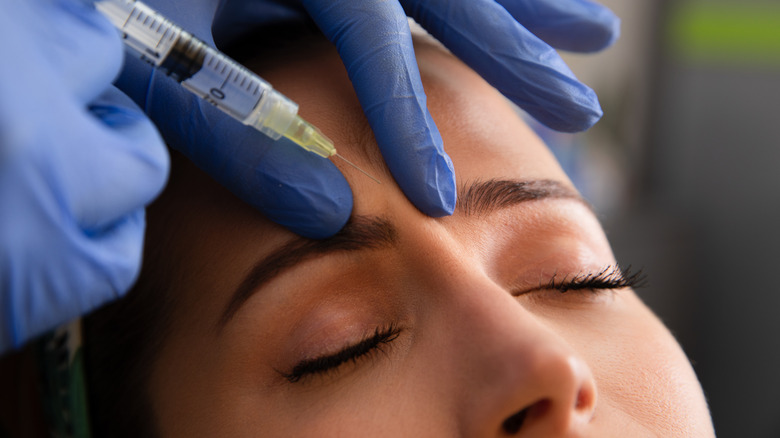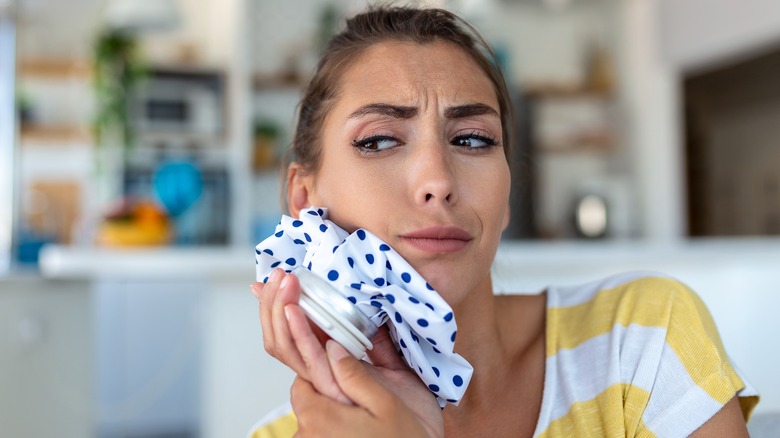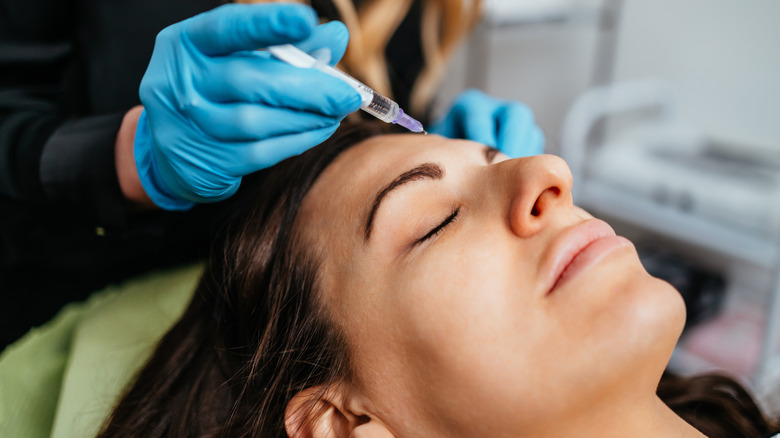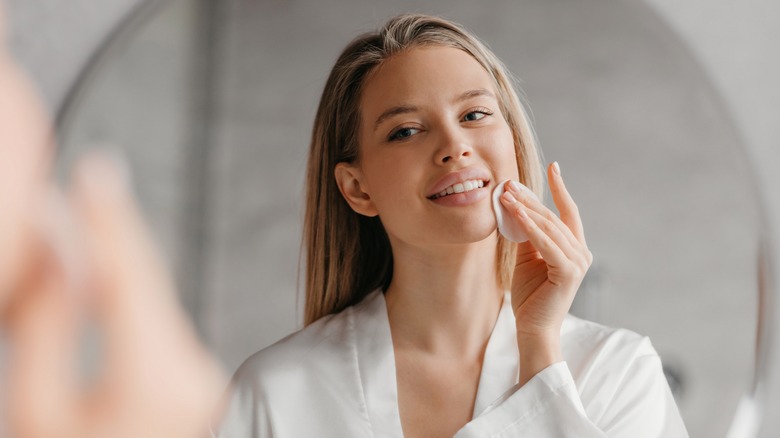What To Do Immediately After Getting An Injectable Treatment
We may receive a commission on purchases made from links.
Getting injections has become a mainstream beauty and wellness practice, from injections of skin-firming Botox to vitamin B12 injections. While many people opt for injectable treatments for personal reasons, the solutions commonly injected through in-office procedures can also be used to treat medical conditions such as chronic migraine, Tourette's Syndrome, and hyperhidrosis, per Healthline. Regardless of the reason for obtaining the injectable, the aftercare remains the same and is equally important no matter the solution that has been injected since your body will be absorbing a new substance in the immediate aftermath of the procedure. Just like when you get your flu shot or any other form of injection, there are some critical tidbits of information to know before you receive the injectable solution so that you know how to care for yourself in the following hours, days, or even weeks.
Whether your healthcare provider delivers instructions for how to proceed after you receive the injection or you self-educate on the matter, it's best to be aware of the correct aftercare practices before obtaining any injectable since not being informed can lead to detrimental side effects (via WebMD). Another reason to know proper aftercare is so that you can keep an eye out for any signs of these harmful side effects, such as swelling, allergic reaction, or infection at the injection site. If you're ever concerned, speak with a medical professional as soon as possible. Otherwise, here's what you should know about caring for yourself after receiving an injectable treatment.
Ice, ice, and more ice
When you receive any kind of injectable treatment, you'll want to know how to care for yourself immediately after the injection. One of the best items you can bring to your appointment is an ice pack. You can even pack a small cooler bag with a couple of ice packs to use while at your appointment. A 2010 study published in the Journal of the Medical Association of Thailand discovered that there are numerous benefits to applying ice to the site where an injection will take place approximately five minutes before receiving the injectable treatment and then applying a second ice pack to the same location an estimated five minutes after the procedure is performed. For patients who received Botox injections, researchers found that the application of ice both before and after the injectable procedure resulted in significantly reduced pain and less bleeding at the injection site.
Once you've left the appointment and you're back home, it's safe to use ice on the injection site in intervals of five to 10 minutes at a time, though the ice or cold pack should never touch the injection site directly and should instead be covered by a towel or cloth, advises Derosa Clinic. If you've received a Botox injectable treatment, be mindful not to place too much pressure on the site of injection, as doing so could move the solution around to unwanted areas of your face or body.
Know the do's and don'ts of aftercare
Ice is one of the most helpful items you'll utilize both before and after your injectable treatment, though it isn't the only beneficial recovery tool. Knowledge is extremely powerful when it comes to your body, and recovering from an injection is no exception. In addition to using a cold compress for up to 10 minutes at a time, you'll want to be aware of the things you should and shouldn't do after receiving your injectable treatment. Following the use of ice, two of the most important things to do post-injection are to remain elevated, effectively refraining from placing pressure on the injection site and maintaining a relaxed state, in which your heart rate is kept down so as not to strain the healing process, per Aedit.
You'll likely be advised to avoid exercise and getting the injection site wet for a set number of hours after the procedure is performed. WebMD recommends staying away from sources of heat and moisture, including intense humidity, such as through the use of a hot tub, warm bath, or sauna, for a minimum of four hours post-injection. After facial injections, the experts at Healthline recommend staying away from any product that touches your face, such as exfoliating facial scrubs or cleansers, derma rollers, and gua sha or similar facial massaging tools. Following an injectable treatment, stay out of direct sunlight and avoid using tanning beds.
Track post-injection symptoms
One factor to be informed about is the topical solution applied to your skin to sterilize the area where the injection will take place. For most injectable treatments, your provider will use a pre-soaked wipe or cotton swab containing a topical antiseptic solution intended to cleanse and sterilize your skin, ridding the area of any infection-causing bacteria, microorganisms, or foreign pathogens. Common antiseptic solutions used during injectable treatments include isopropyl alcohol and chlorhexidine, often known under the brand name Hibiclens, both of which are alcohol-based or otherwise include elements, which can lead to side effects varying from dry skin to serious allergic reactions. Anaphylaxis UK warns that an allergic reaction to topical antiseptics, particularly solutions containing chlorhexidine, can occur immediately upon contact with the ingredients or appear via a delayed reaction up to three days following use on the skin. Iodine is another ingredient commonly used in perioperative sterilization that can lead to skin irritation, rash, dermatitis, and potential allergic reaction (via AAAI).
It's critical to track any side effects, including skin irritation or any other noticeable reaction. With Botox injections, be aware of swelling or pain, which can be an adverse reaction to the antiseptic or injected solution, advises Barnett Dermatology. Facial swelling, sudden onset of drooling, or drooping of one or both eyelids are symptoms that shouldn't be ignored. Should you notice adverse reactions at any time in the days following your procedure, notify your healthcare provider. If your symptoms become serious, seek medical care.
Maintain skin hydration through moisturization
Bringing ice packs to your appointment isn't the only preparedness product you can have on hand for achieving the best results in your post-injection recovery efforts. To prevent post-operative skin dryness, you may be able to apply moisturizer after the injection to restore hydration to your skin, though only with your healthcare provider's approval. The most common reason dryness occurs following injections is because of alcohol-containing topical sterilization solutions applied to the injection site. The Derm Review reports that alcohol-based antiseptic solutions are known to cause skin dryness by stripping natural hydration. Taking proper care to keep skin moisturized is an important deterrent to developing irritation post-injection.
Sometimes, though, it's the injectable solution itself that seeds skin dryness. Injections involving cortisone given to relieve arthritis and joint pain can cause drying at the injection site, says Urgent Care Omaha. For optimal results in deterring dry skin, look for moisturizers with hyaluronic acid, as it can help rapidly restore hydration (via Healthline). Ask your healthcare provider when moisturizer can safely be applied to the injection site, and always adhere to their instructions.
To minimize the risk of infection-causing substances entering your skin during the procedure, always arrive at your appointment with clean skin. Taking a shower with antibacterial soap prior to your procedure and avoiding the application of lotions, serums, makeup products, or other cosmetic items to your skin will contribute to preventing foreign agents from entering the injection site, ultimately reducing your risk of infection.
Make space for your recovery period
Though you don't have to be completely inactive and can most likely be able to perform many of your regular daily tasks, consider the first 24 to 72 hours after receiving an injectable treatment as a good opportunity to prioritize rest, self-care, and give yourself the permission to relax. While you'll want to avoid a full workout, moving the muscles of your face on their own, otherwise without touching your face, is something you may be instructed to do if you've received a Botox injection or similar injectable treatment, reports Healthline.
Prior to your appointment, spend some time setting up a recovery space for yourself in your bedroom or another part of your home that feels cozy to you. Since you won't want to lay down for the first several hours after the injectable treatment, set up a space that includes a chair or pillow backrest that can keep you upright and elevated while you enjoy lounging activities, like watching a movie, reading a book, listening to a podcast, or meditating. You can use your recovery period to respond to emails and handle other matters, but be certain that you aren't allowing yourself to become overly stressed as doing so could deter your body's recovery process. Aim for low stress, but also allow yourself to enjoy the time to relax post-recovery since many of us are prone to feeling guilty if we aren't constantly being productive. Remember that caring for yourself is productive.
H20 is the way to go
A variety of injectable treatments, including Botox and vitamin B12 injections, share post-procedure symptoms and recovery advice. After receiving an injection, just like when you get your flu shot or another form of medical injection, you may experience a headache afterward, which can worsen with dehydration (via Eating Well). Those at Healthline reveal that a dull headache can persist following a vitamin B12 injection. Identical to recovery from Botox treatments, aftercare for B12 injections also include avoiding athletic workouts for the first 48 hours, and refraining from touching the injection site for the same amount of time unless otherwise advised by your healthcare provider, as per Mae Cosmetics.
Another rule of thumb is to avoid alcohol for the first few days post-treatment. Instead, make certain that you eat a nutritious diet and drink plenty of water, as consuming sufficient amounts of water following injection procedures can provide needed hydration and increase the injected solution's effects, which is especially true for Botox treatments, shares Westover Hills Dermatology. As you're setting up your post-treatment recovery space in your home before leaving for your injectable treatment appointment, fill up a large water bottle and place it next to where you'll be recovering, in addition to bringing water with you to drink before and immediately after your injection is performed. When receiving an injection, think of good ol' H20 as your BFF since both ice and water will give you the boost you need for an optimal recovery.






